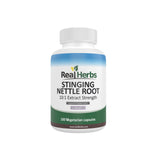Which Is Better Stinging Nettle Root Or Leaf?
Introduction: Stinging nettle, scientifically known as Urtica dioica, is a herbaceous plant with a long history of use in traditional medicine. Its roots and leaves are known for their potential health benefits. In this article, we will explore the characteristics, uses, and potential advantages of stinging nettle root and leaf, aiming to help you make an informed decision regarding which form may be more suitable for your needs.
Background Information: Stinging nettle is a perennial plant found in various regions around the world. Throughout history, it has been utilized for its medicinal properties, particularly in herbal remedies. The plant contains fine hairs that release chemicals upon contact, causing a stinging sensation, hence its name. Both the root and the leaves of stinging nettle have been traditionally used for their therapeutic effects.
Stinging Nettle Root: The root of the stinging nettle plant is rich in bioactive compounds, including plant sterols, lignans, and polysaccharides. It has been primarily associated with urinary health and prostate support. Research suggests that stinging nettle root may help alleviate symptoms of benign prostatic hyperplasia (BPH), a non-cancerous enlargement of the prostate gland. Studies have shown that certain compounds in the root may inhibit the conversion of testosterone to dihydrotestosterone (DHT), which contributes to prostate enlargement. Moreover, stinging nettle root possesses anti-inflammatory properties, potentially providing relief for joint pain and arthritis.
Stinging Nettle Leaf: The leaves of stinging nettle are packed with nutrients, including vitamins A, C, and K, as well as minerals such as iron and calcium. Traditionally, stinging nettle leaf has been used to address allergies, thanks to its potential anti-inflammatory and antihistamine properties. It may help reduce symptoms such as sneezing, itching, and nasal congestion. Furthermore, the leaf has been explored for its potential benefits in managing joint pain, skin conditions like eczema, and supporting overall immune health.
Key Differences: While both stinging nettle root and leaf offer health benefits, there are notable differences between the two. Stinging nettle root is commonly associated with prostate health and urinary issues, making it a suitable choice for individuals with BPH or related concerns. On the other hand, stinging nettle leaf is often favored for its role in managing allergies and supporting joint health. Depending on your specific needs, you may choose one form over the other.
Safety and Precautions: Stinging nettle is generally considered safe when used appropriately. However, some individuals may experience mild side effects such as gastrointestinal discomfort or skin irritation. It is important to consult with a healthcare professional before using stinging nettle, especially if you have any pre-existing conditions, are taking medications, or are pregnant or breastfeeding.
Conclusion: Stinging nettle, both in its root and leaf forms, offers potential health benefits backed by traditional use and scientific research. Stinging nettle root shows promise in supporting prostate health and reducing inflammation, while stinging nettle leaf may aid in managing allergies and promoting joint health. Ultimately, the choice between root and leaf depends on your specific health concerns and goals. To ensure safe and effective use, consult with a healthcare professional who can provide personalized guidance based on your individual circumstances.












